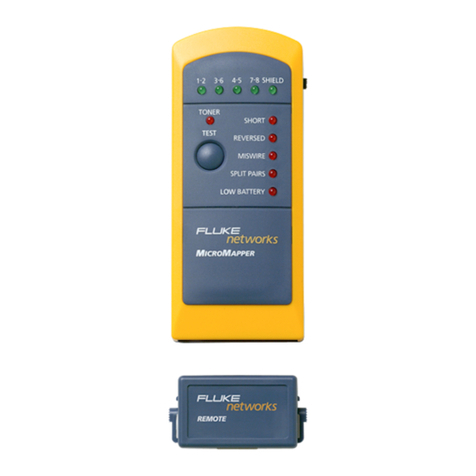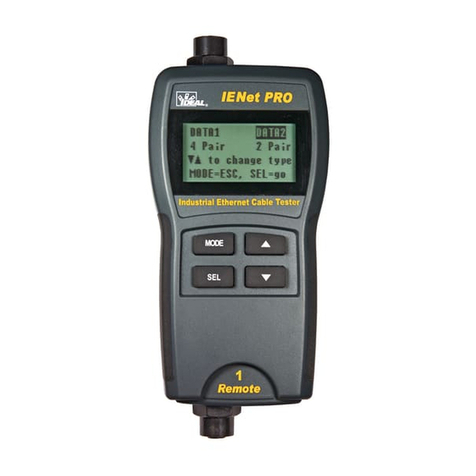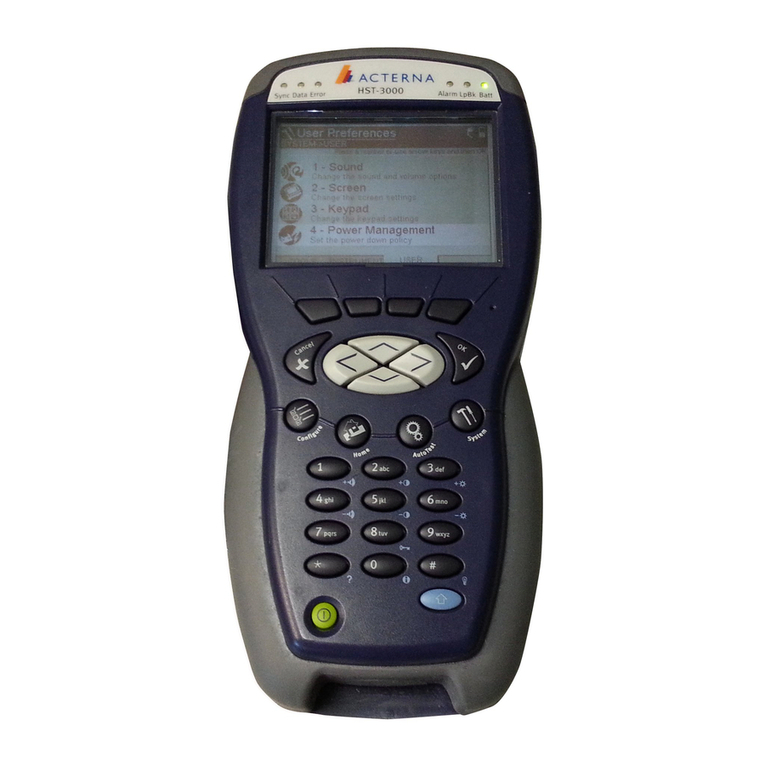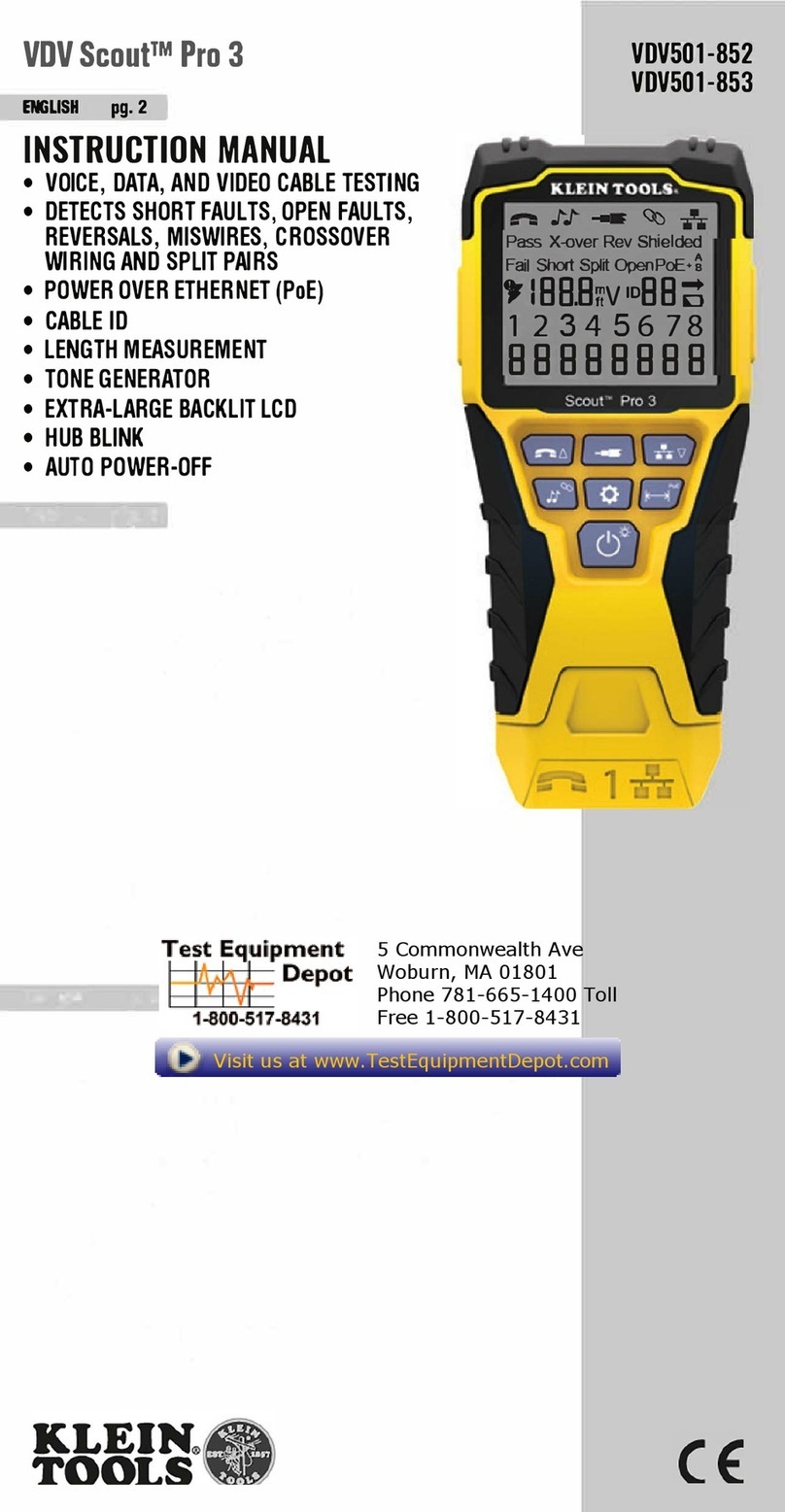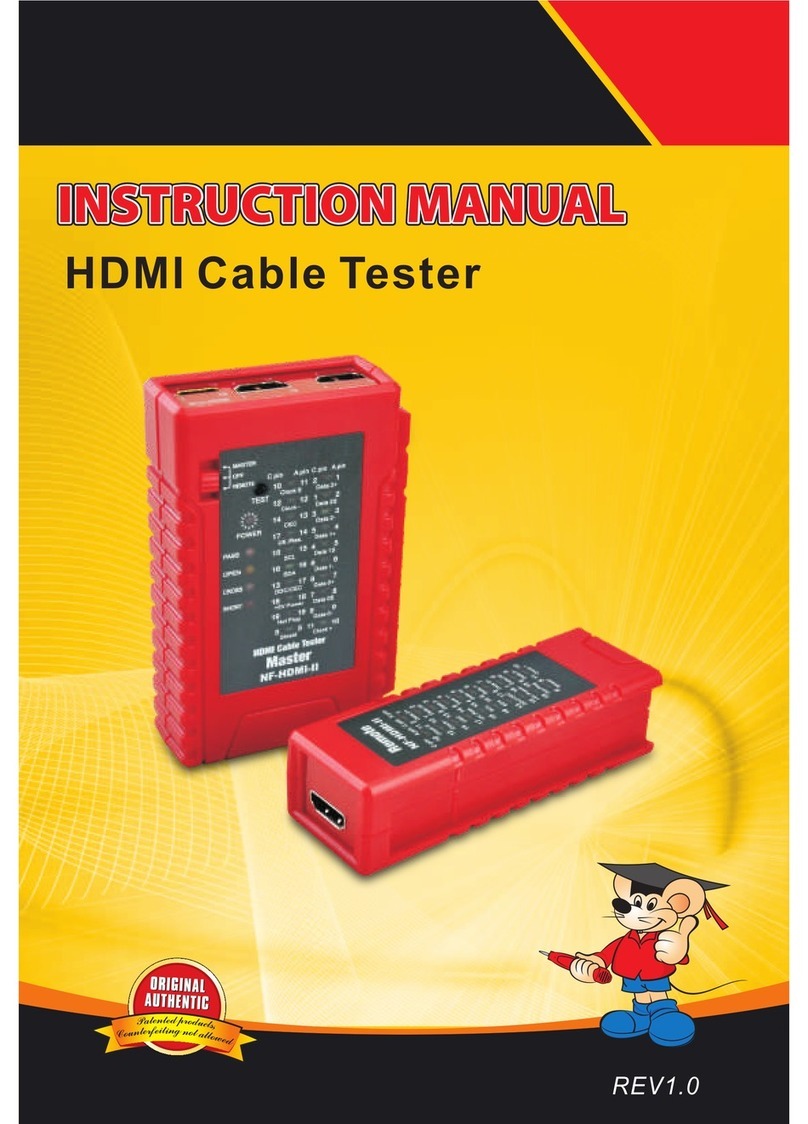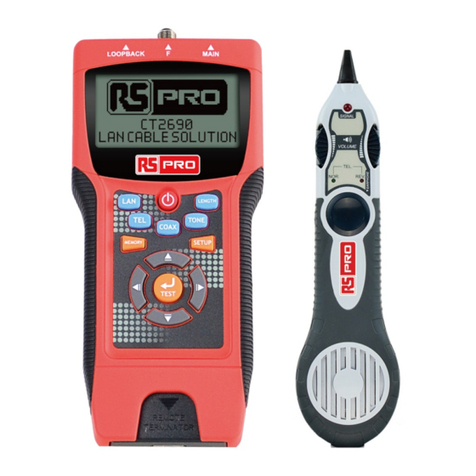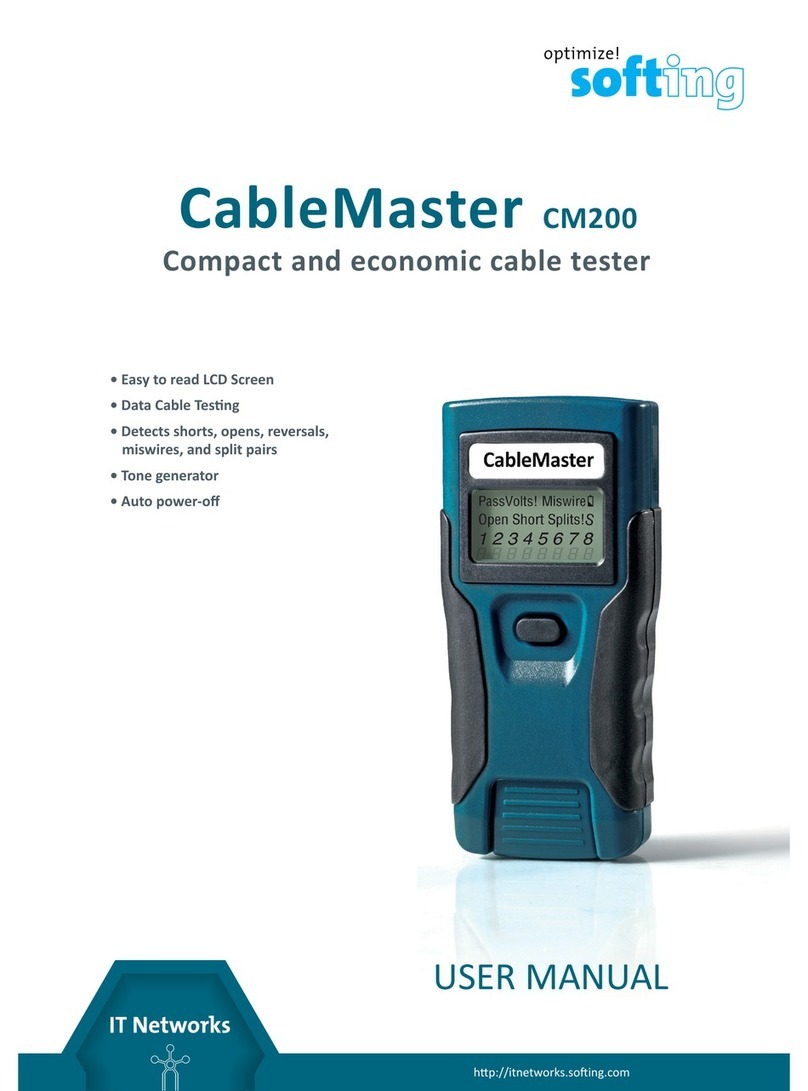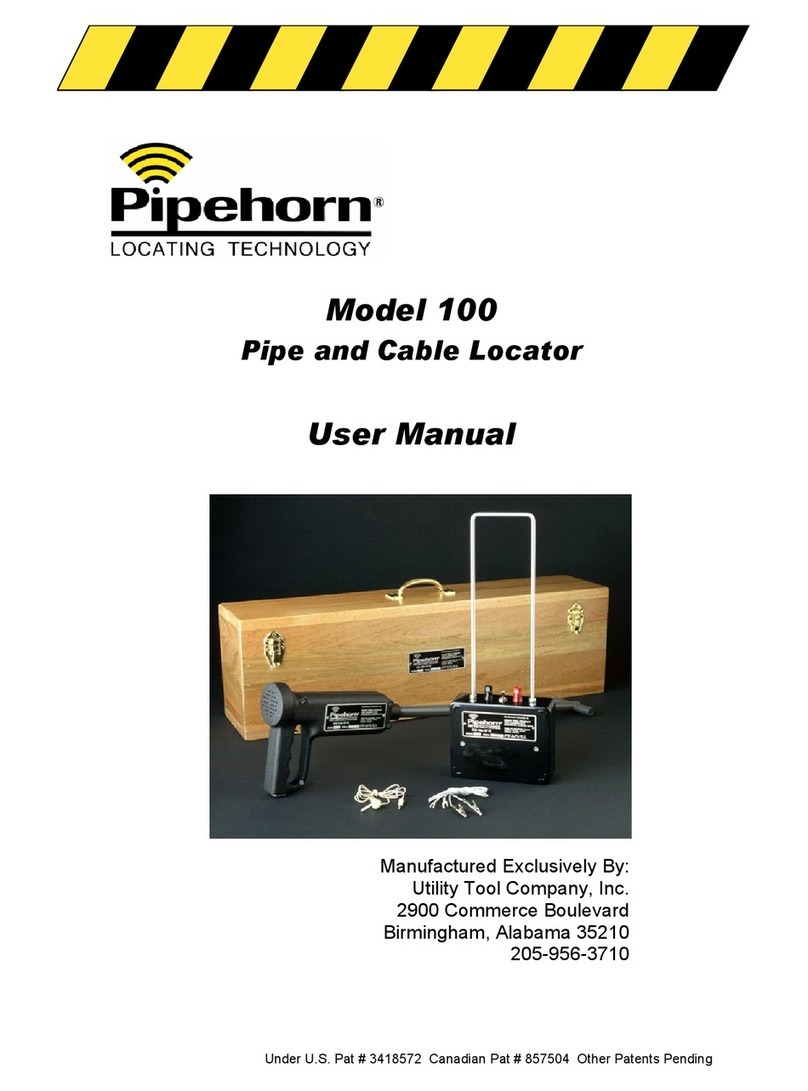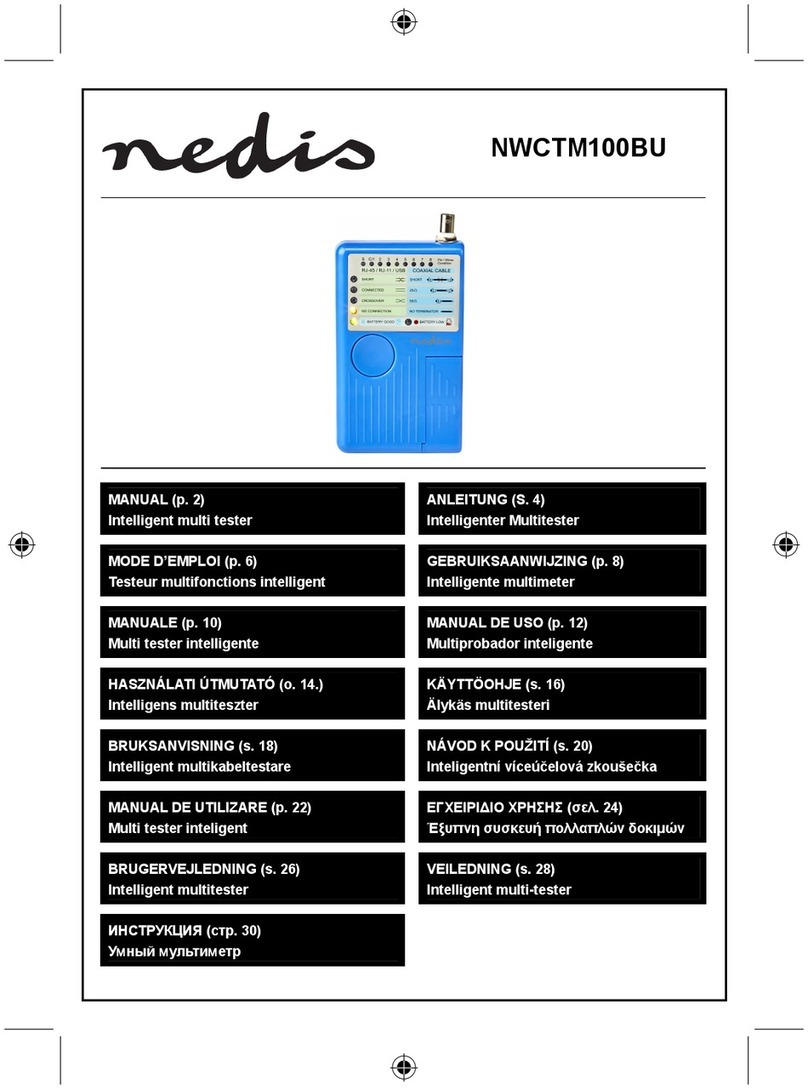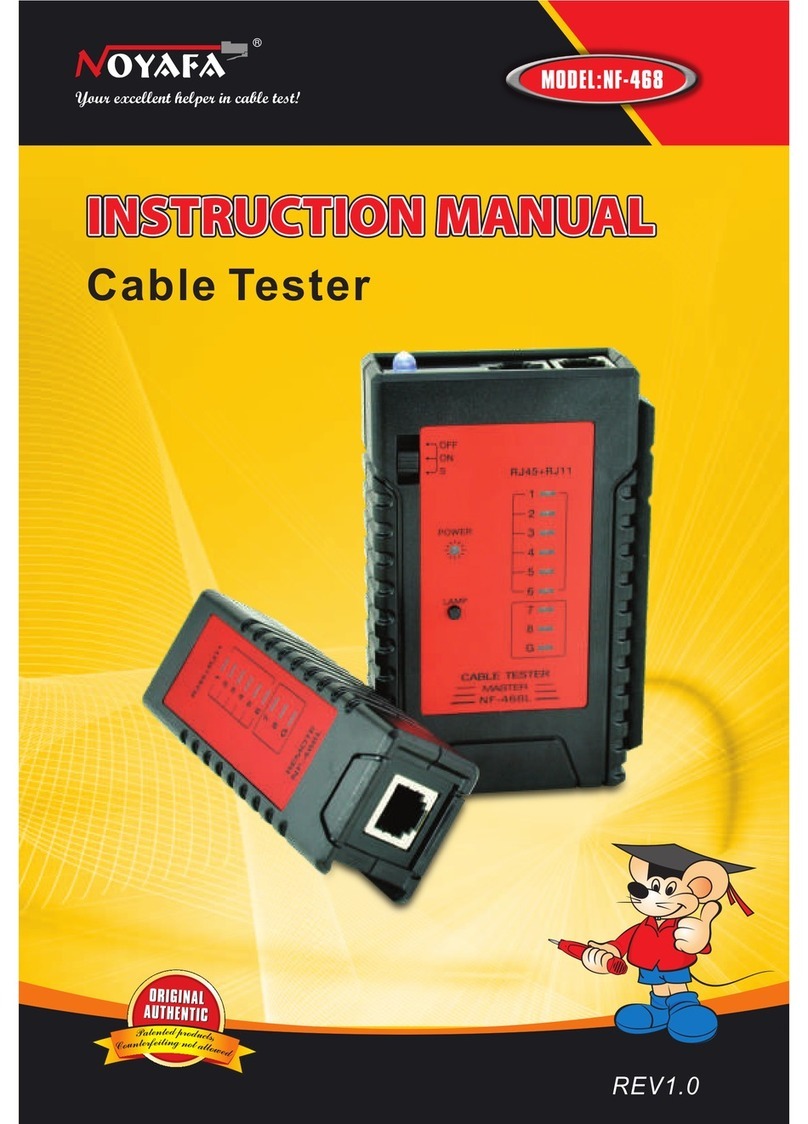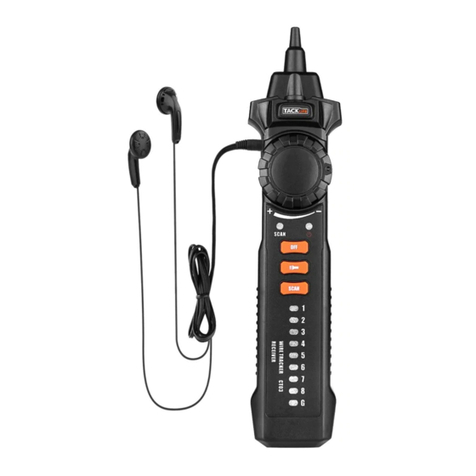Megatel LCT-300 User manual

MODEL: LCT-300/400
LAN Cable Tester User’s Guide
Welcome
Thankyou for purchasing this LAN Cable Tester Series product. Whether you are a contractor installing LAN cabling as a profession or simply a small office
administrator caring for a LAN, we hope you find this product both useful and rewarding.
Recognised Wiring Schemes
•10(100) Base-T
•Token Ring
•TP-PMD
•plus 4 User Defined
•AT&T 258A
•EIA/TIA-568A/B
•USOC
•BNC/10Base-2
•10(100) Base/HUB
•BNC/10Base-2
Specifications
•LCD Display: 2 lines by 12 characters with LED back light.
•Connectors: (2) RJ-45 (8P8C) jacks with shield.
•Control keys: (3) MODE/SEL,ESC and ENTER buttons.
•Power: (1) 9V dry cell battery.
•Size: 15.0(H) x 6.5(W) x 3.5(D)
•Weight: 180g net.
Cable Types
•Unshielded Twisted Pair (UTP 100Ω, Cat 3,4 & 5)
•Foil screened Twisted Pair (FTP 100 Ω, and 120Ω, Cat 3,4
& 5)
•Shielded Twisted Pair (STP 150ΩIBM Type 1 & 6)
•RG-58 Coaxial Cable (LCT-400 ONLY)
Features
•Hand-held and easy to operate.
•Easy to diagnose Rj-45 cables (and BNC types with
LCT-400) with preset wiring schemes.
•Easy to read cable status, verify cable continuity:
open short and mismatches.
•Scan pin assignment.
•Automatic cable identification (cable type search).
Cable Locator
Cable Location may be accomplished by using LCT-T terminators. The LCT-T locators incorporate factory set I.D numbers and are available in IDs from 1 to 16.
•Standard pin configurations and four (4) user defined cable wirings memorised in CPU.
•Can save user defined cable directly after testing.
•Tests for both shielded and unshielded cable types.
•Review the captured pin assignment and failure status.
•Maximum testing length is up to 3000 feet.
•Identify and trace the other’s end ID (with up to 16 individual ID LCT-T).
•Battery low indicator.
•Auto power-off function.
Automatic Power Saving Features
The LCT-300/400 has built in power management features intended to extend battery life. By far, the LCD back light is the most power hungry component in the
LCT-300/400. Use of the LCD back light should therefore be limited to low ambient light applications. The backlight may be toggled ON/OFF by simultaneously
pressing the MODE/SEL and ESC function keys. If there is no further menu selection or function testing within thirty (30) seconds, the back light will be
automatically extinguished. Additional power management options include both a “sleep” mode and an auto “power off” mode. If there is not any key activity for
three (3) minutes, the unit will automatically enter “sleep” mode. All interface circuitry and the LCD display will be powered down. In this mode the unit draws very
little power. Pressing any key will cause the unit to “wake up” to a full functioning state. However if there is no key activity for ten (10) minutes, the unit will
automatically “power off”. To recover from “power off” mode, the unit must have its power switched OFF and then ON. In the “power off” mode the power usage
is close to nil. This feature is especially useful if the unit is inadvertently left powered on. The battery should be replaced when the power low icon on the LCD
display becomes visible during normal use of the LCT-300/400. Additionally, if a low battery is swapped within 1 minute with a new one, the user defined memory
contents will be retained. Just remember to turn the unit OFF before swapping the battery.

Operation
1) Connection The LCT-300/400 is capable of testing cables in any one of four modes.
Local Test mode is accomplished by connecting both
ends of the cable under test to the LCT-300/400’s OUT
and LOOPBACK IN ports. Local unit displays an ID
equal to zero.
Terminator Loopback mode uses the terminator ID block connected at the
remote end of the cable, while the other end of the cable is connected to the
LCT-300/400’s OUT.
Remote test mode uses two (2) LCT-300/40
0
units, with the cable connected between one
unit’s OUT and the other unit’s LOOPBAC
K
IN ports. Local unit displays an ID equal to
zero.
10BASE-2 Test uses the supplied RJ-45 to BNC adaptors
(LCT-400 only). The adaptors may both be placed in the
LCT-400’s OUT while the other is placed on the
terminator for LOOPBACK testing.
2) ►Turn Power Switch on: Following initial power on of the LCT-300/400, the unit will display the start up logo with back light for 3 seconds, then will
display the top menu for “cable test”.
3) LCT-300/400 test menu
4)LCT-300/400 test menu
5) Press enter to test the cable
6)Results displayed
7)Use MODE/SEL to toggle between cable pin out screen and result display, press ESC back to test menu.
Cable testing: During any mode of cable testing, the first screen display will show the top line out and bottom line in of connections 1 through 8 plus G (shield) as
they are scanned. Following this screen page will be the cable identification information. If at least one wire pair is not connected, the display will read “NO
CONNECT”. A shorted cable will read “SHORT”. A question mark in the pin out indicates a short. An unknown is not in the standard known pin outs or in the
user defined memory.
User Defined Cable: The User Define function allows you to describe your own custom cable pin out which will be entered into the cable identification database
and saved in the CPU memory. This custom pin out will remain available as long as a fresh battery is in the unit. Two methods are available for defining a cable.
The first method is manual entry, while the second uses an “UNKNOWN” cable as the pin out source. First the manual method. From the very top of the LCT-
300/400 menu (just after power on is completed) select the USER DEF menu by pressing the MODE/SEL button (step no.1 to 2). The MODE/SEL button will
now move the cursor to select one of four user memory locations (step no. 3). Press ENTER to select the memory location that the cursor is on. The define cable
display will show (step no. 4).
LCT-300/400 test menu
LCT-300/400 user defined menu
LCT-300/400 user defined display
LCT-300/400 Define cable display
Use the ENTER key to set digits 1 – 8, G or blank (not connected), then press MODE/SEL to move to the next space.
When complete press ESC (step no. 5 to 6).
LCT-300/400 defined pin out
LCT-300/400 Save to user defined Confirmation Display
To save your definition press ►ENTER. To exit without saving, press ►ESC. The alternate method is to save the “UNKOWN” type.
Cable Fault Indication Examples:
In the above example, Pin 1 and Pin 2 were found to be shorted.
In the second example, if at least one pair of wires is not connected, the test result will show as “NO CONNECT”.
LAN CABLE
TESTER vX.X MODE SEL
Cable test
O 12345678G
I 36145278
100BASE/HUB
UTP id:1
Battery Low Icon
Pin Out Type
Terminator
ID No.
UTP, FTP or COAX
MODE SEL:
cable test
MODE SEL:
user defined
►MODE/SEL ►ENTER
USER DEF:
# 1/2/3/4
►MODE/SEL to
location1~4. then
►ENTER o 12345678G
i Empty
o 12345678G
i 36145278
►ESC
Defined Pin Out
SAVE TO USER
DEF. #2 ?
MODE SEL:
cable test
►ENTER o 12345678G
i 11345678
CABLE SHORT
id:1
MODE SEL:
cable test
►ENTER o 12345678G
i
NO CONNECT
This manual suits for next models
1
